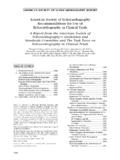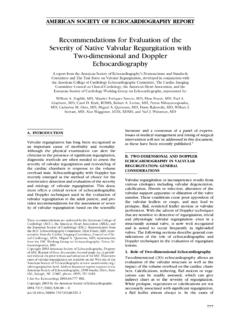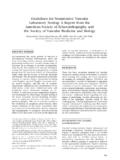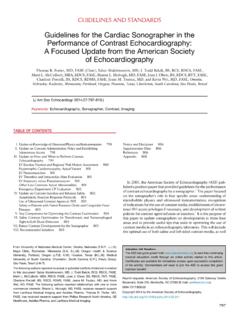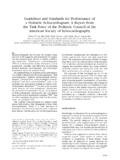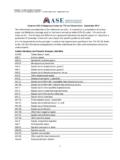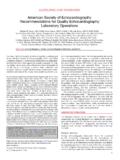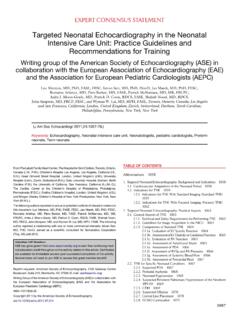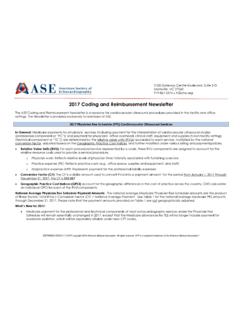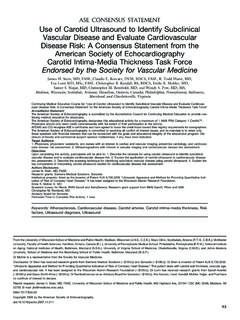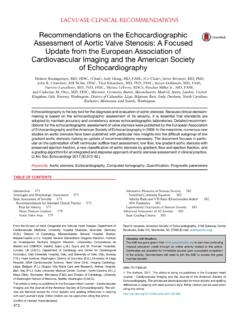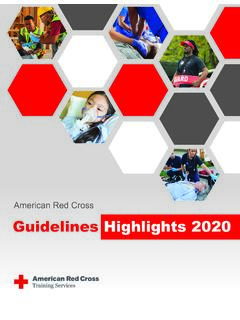Transcription of Guidelines for Performing a Comprehensive Transesophageal ...
1 ASE Guidelines AND STANDARDSG uidelines for Performing a ComprehensiveTransesophageal Echocardiographic Examination: recommendations from the american society ofEchocardiography and the society of CardiovascularAnesthesiologistsRebecca T. Hahn, MD, FASE, Chair, Theodore Abraham, MD, FASE, Mark S. Adams, RDCS, FASE,Charles J. Bruce, MD, FASE, Kathryn E. Glas, MD, MBA, FASE, Roberto M. Lang, MD, FASE,Scott T. Reeves, MD, MBA, FASE, Jack S. Shanewise, MD, FASE, Samuel C. Siu, MD, FASE,William Stewart, MD, FASE, and Michael H. Picard, MD, FASE,New York, New York; Baltimore, Maryland;Boston, Massachusetts; Rochester, Minnesota; Atlanta, Georgia; Chicago, Illinois; Charleston, South Carolina; London,Ontario, Canada; Cleveland, Ohio(J Am Soc Echocardiogr 2013;26:921-64.)
2 Keywords: Transesophageal echocardiography , Comprehensive examinationTABLE OF CONTENTSI ntroduction 921 General Guidelines 922 Training and Certification 922 Indications for TEE 923 Management of Patient Sedation 927 Sedation and Anesthesia 929 Probe Insertion Techniques 930 Instrument Controls 930 Instrument Manipulation 931 Comprehensive Imaging Examination 932ME Views 932TG Views 939 Aorta Views 941 Transesophageal 3D Examination Protocol 942 Specific Structural Imaging 942MV 942AV and Aorta 945PV 949TV 950 Assessment of Ventricular Size and Function 951LA and Pulmonary Veins 953 Right Atrium and
3 Venous Connections 954 ACHD: TEE Imaging Algorithm 957 Conclusions 959 References 959 INTRODUCTIONT ransesophageal echocardiography (TEE) is a critically important car-diovascular imaging modality. The proximity of the esophagus toFrom Columbia University, New York, New York ( , ); Johns HopkinsUniversity, Baltimore, Maryland ( ); Massachusetts General Hospital, Boston,Massachusetts ( , ); Mayo Clinic, Rochester Minnesota ( );Emory University School of Medicine, Atlanta, Georgia ( ); the University ofChicago, Chicago, Illinois ( ); Medical University of South Carolina,Charleston, South Carolina ( ); University of Western Ontario, London,Ontario, Canada ( ); and Cleveland Clinic, Cleveland, Ohio ( ).
4 The following authors reported no actual or potential conflicts of interest inrelation to this document: Rebecca T. Hahn, MD, FASE, Theodore Abraham,MD,FASE, ,RDCS,FASE, ,MD,FASE,JackS. Shanewise, MD, FASE, Samuel C. Siu, MD, FASE, William Stewart, MD,FASE, and Michael H. Picard, MD, FASE. The following authors reported re-lationships with one or more commercial interests: Kathryn E. Glas, MBA,MD, FASE, edited and receives royalties forThe Practice of PerioperativeTransesophageal echocardiography : Essential Cases(Wolters Kluwer Health,Amsterdam, The Netherlands). Roberto M. Lang, MD, FASE, received re-search support from Philips MedicalSystems (Andover, MA).
5 Scott , MD, MBA, FASE, edited and receives royalties forA Practical Ap-proach to Transesophageal echocardiography (Lippincott Williams & Wilkins,Philadelphia, PA).Attention ASE Members:The ASE has gone green! earn free continuingmedical education credit through an online activity related to this are available for immediate access upon successful completionof the activity. Nonmembers will need to join the ASE to access this greatmember benefit!Reprint requests: american society of echocardiography , 2100 Gateway CentreBoulevard, Suite 310, Morrisville, NC 27560 2013 by the american society of of the heart and great ves-sels makes it an excellent ultra-sonic window, so that TEEprovides additional and more ac-curateinformation thantranstho-racic echocardiography (TTE) forsome patients, for several specificdiagnoses and for many catheter-based cardiac ultrasound was firstreported in 1971 to measureflow in the aortic followed in 1976 by its usewith M-mode echocardiogra-phy2and then in 1977 by two-dimensional (2D)
6 Imaging usinga mechanical scanning modern era of TEEreally began in 1982, with the in-troduction offlexibleprobeswithphased-array transducers andmanipulabletips,4initiallyasasin-gle, horizontally oriented trans-ducer (monoplane), next as twoorthogonally oriented trans-ducers (biplane), and then as ad-justable transducers capable ofrotating 180 within the tip ofthe probe (multiplane). More re-cently, Transesophageal echocar-diographic probes and systemscapable of producing real-timethree-dimensional (3D) imageshave been developed and haveachieved wide 1999, the american Societyof echocardiography (ASE) andthe society of CardiovascularAnesthesiologists (SCA)
7 Pub-lished Guidelines for performinga Comprehensive intraoperativemultiplanetransesophageale chocardiographic examina-tion5,6that defined and named a set of 20 transesophagealechocardiographic views intended to facilitate and provideconsistency in training, reporting, archiving, and quality the Comprehensive intraoperative views have beenwidely adopted, they have a number of limitations. They wereintended for intraoperative imaging and do not include some viewsimportant to other applications of TEE. The 20 views do notaddress any specific diagnoses and do not include some viewsneeded to adequately examine common cardiac disorders.
8 Withsignificant advancement in technology, TEE has proven utility ina number of clinical arenas,7-12including the operating room,intensive care unit, interventional laboratory, and outpatient , TEE has become an essential imaging tool for cardiacsurgeons, anesthesiologists, cardiac interventionalists, and clinicalcardiologists. The present document is thus intended to be a guideto TEE in the following situations:1. Diagnostic TEE: TEE performed to address a specific diagnostic question2. Intraprocedural TEEa. Surgical-based procedureb. Catheter-based procedureThe writing group acknowledges that individual patient characteris-tics, anatomic variations, pathologic features, or time constraints im-posed on Performing TEE may limit the ability to perform all aspectsof the examination described in this document.
9 Although thebeginner should seek a balance between a fastidiously complete, com-prehensive examination and expedience,an experiencedechocardiog-rapher can complete the examination described here in a reasonabletime period. The writing group also recognizes that there may be otherentirelyacceptableapproachesandview sofatransesophagealechocar-diographic examination, provided they obtain similar information ,althoughthisdocumentpresentsasuggestedp rotocolofimageacquisition,theorderandnum berofviewsmaydifferfor various indications. For some indications, additional special viewsare recommended, and these are described in the Specific StructuralImaging sectionofthis documentisnot intendedtore-view specific indications for TEE or to cover extensively abnormalitiesseen with this present guideline is divided into the following sections:1.
10 General guidelinesa. Training and competenceb. Indications for TEEc. Sedation and anesthesiad. Probe insertion and manipulation2. Comprehensive Transesophageal echocardiographic imaging examinationa. Comprehensive 2D imaging examination3. Specific structural imaging with TEEa. Mitral valve (MV) imagingb. Aortic valve (AV) and aorta imagingc. Pulmonic valve (PV) imagingd. Tricuspid valve (TV) imaginge. Assessment of ventricular size and functionf. Left atrium and pulmonary veinsg. Right atrium and venous connectionsh. Adult congenital heart disease (ACHD): Transesophageal echocardio-graphic imaging algorithmGENERAL GUIDELINEST raining and CertificationThere are several published Guidelines addressing training and main-tenance of competence for physicians Performing TEE that aresummarized inTable is a prerequisite to TEE forcardiology-based training but not anesthesiology-based of competence in TEE is usually accomplished by suc-cessful completion of a training program and passing an National Board of echocardiography , founded in 1998 incollaboration with the ASE and SCA.
